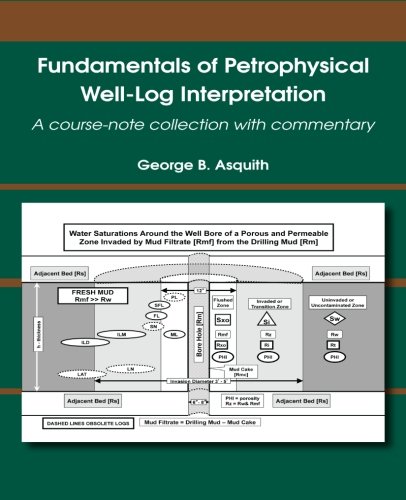Articoli correlati a Fundamentals of Petrophysical Well-Log Interpretation:...
Fundamentals of Petrophysical Well-Log Interpretation: A course-note collection with commentary - Brossura

Petrophysical well-logs are incremental-depth records of rock, mineral, fluid, and other properties of the subsurface. Well logs and the practice of well-log interpretation by geologists and petroleum engineers represent a critical component of the exploration and assessment of potential hydrocarbon producing formations and reservoirs. The fundamentals of petrophysical well-log interpretation are presented in this monograph, which is a compilation of slide-oriented course notes and commentary created by the author over many semesters of undergraduate and graduate class-room instruction and is designed as a self-teaching guide with worksheets. Chapter 1 is an introduction to well-log interpretation, reviews discipline terminology, the types and uses of various well logs, and how the analyst might visually review logs in an effort to identify potentially productive zones of hydrocarbons. Chapter 2 introduces the reader the borehole environment and a view of the zones in a porous and permeable formation that has been invaded during drilling. The algorithmic steps are presented for computation of formation temperature from data on the log header. Chapters 3–7 present to the user the general information and characteristics of the various well logs including what individual well logs are designed to measure and how tool measurements are converted to appropriate units needed for hydrocarbon production assessment. Each chapter presents well-log analysis for two well-known Cretaceous formations: Glen Rose and Frontier. Chapter 8 reviews the critically important “Archie Parameters” that subsequently are used in Chapter 9 to compute the water saturations of the Glen Rose and Frontier formations using the Archie water-saturation equation. In prior worksheets, the reader is guided to the determination that the Frontier formation is a shaly sandstone and therefore the specific methods of “shaly-sandstone analysis” are required. Chapter 10 is a review of additional techniques used to progressively refine interpretation of the two formations through well-log analysis. Additional techniques demonstrated include guidance on the user answering the following questions: (1) Are the hydrocarbons calculated within Chapter 9 moveable? (2) Are the two formations “water-wet” or “oil-wet?” (3) What are the pore types within the Glen Rose? (4) Should the Glen Rose and Frontier formations individually make “water-free completions.” Similar to the other chapters, the information acquired and computations by the user are oriented around worksheets so that final interpretations of each formation can be made. Chapter 11 introduces and extensively reviews techniques useful for the evaluation of hydrocarbon potential in unconventional shale reservoirs using the standard well-log suite comprised of resistivity, neutron porosity, and bulk density logs. The techniques will be presented along with four case studies of the gas-bearing Woodford Shale and the three oil-bearing shales (Permian Leonard shale and two Permian Wolfcamp shales). Although the focus of the self-guided components of the monograph are generally restricted to a few select formations. The monograph includes considerable information and examples of, the well logs, host-rock properties (sandstones, shales, ...), and reservoirs within other formations discussed include: Ordovician Gunton; Devonian Marcellus; Mississippian Barnett, Chester, Mission Canyon; Pennsylvanian Canyon, Springer, Morrow, and Upper Morrow; Permian Bone Springs, Glorieta, and San Andres; Triassic Montney; Cretaceous Lewis, Pictured Cliffs, and Woodbine. The slides and commentary in this monograph are expected to be useful to a broad range of petrophysical well log analysts as tools to practical application as well as ascending for the beginner the formidable learning curve of petrophysical well-log interpretation.
Le informazioni nella sezione "Riassunto" possono far riferimento a edizioni diverse di questo titolo.
L'autore:
George B. Asquith, Ph.D. is a Professor of Geosciences at Texas Tech University, Lubbock, Texas where he has been employed for over 24 years. Collectively, he has almost 40 years of experience in the oil and gas industry within academia and with both major and independent oil and gas corporations. His experience includes both exploration and production geology in the Gulf of Mexico (onshore and offshore), Rocky Mountains, and the Anadarko and Permian basins. He has authored or co-authored over 100 publications including the co-authoring of the immensely popular Basic Well Log Analysis published by the American Association of Petroleum Geologists. His son as published a major monograph of L-moment statistical theory that compliments the statistical tool box of petroleum explorationists (https://www.createspace.com/3615840).
Le informazioni nella sezione "Su questo libro" possono far riferimento a edizioni diverse di questo titolo.
- EditoreCreateSpace Independent Publishing Platform
- Data di pubblicazione2012
- ISBN 10 1477549366
- ISBN 13 9781477549360
- RilegaturaCopertina flessibile
- Numero di pagine628
Compra nuovo
Scopri di più su questo articolo
EUR 63,61
Spese di spedizione:
EUR 11,65
Da: Regno Unito a: U.S.A.
I migliori risultati di ricerca su AbeBooks
Fundamentals of Petrophysical Well-Log Interpretation: A course-note collection with commentary
Editore:
CreateSpace Independent Publishing Platform
(2012)
ISBN 10: 1477549366
ISBN 13: 9781477549360
Nuovo
Paperback
Quantità: 1
Da:
Valutazione libreria
Descrizione libro Paperback. Condizione: Brand New. 628 pages. 9.25x7.50x1.42 inches. This item is printed on demand. Codice articolo zk1477549366
Compra nuovo
EUR 63,61
Convertire valuta

